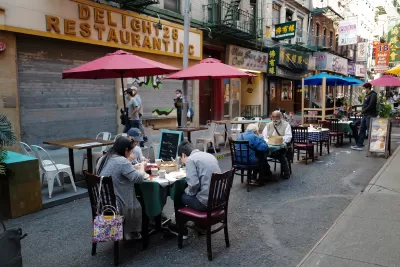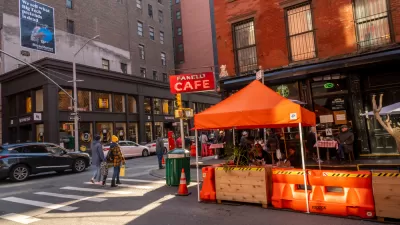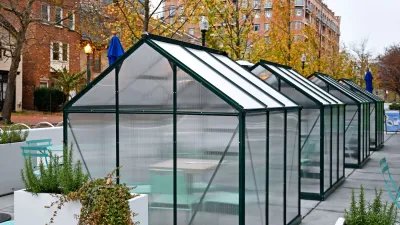Restaurant owners say the city’s new outdoor dining program makes it too difficult and expensive to operate al fresco setups.

Many of New York City’s outdoor dining structures are being removed to make way for (mostly free) parking after restaurants and bars failed to make them compliant with the city’s new requirements.
According to a report by Kevin Duggan in Streetsblog NYC, businesses with non-compliant designs had to take down their setups by November 1, while compliant businesses must remove them by November 29, since the outdoor dining program doesn’t apply in winter months. The new rules, which call for a public hearing for new outdoor dining applications, require that structures be easily removable and lightweight, banning fully enclosed hard structures.
Restaurant owners say the seasonal program makes operating an outdoor dining area more expensive since they must pay for removal and storage during the off-season, and many say they will stop offering outdoor dining altogether. “The numbers of sheds dropped significantly after the new regime first kicked in over the summer, with around 3,000 applications for roadway and sidewalk cafés as of late September, according to the Department of Transportation. Transportation officials estimate that the program peaked at 6,000 to 8,000 participants, including some 5,000 setups as of this summer.”
FULL STORY: Parking? Lots! Outdoor Dining Structures Are Coming Down Across the City

Maui's Vacation Rental Debate Turns Ugly
Verbal attacks, misinformation campaigns and fistfights plague a high-stakes debate to convert thousands of vacation rentals into long-term housing.

Planetizen Federal Action Tracker
A weekly monitor of how Trump’s orders and actions are impacting planners and planning in America.

San Francisco Suspends Traffic Calming Amidst Record Deaths
Citing “a challenging fiscal landscape,” the city will cease the program on the heels of 42 traffic deaths, including 24 pedestrians.

Defunct Pittsburgh Power Plant to Become Residential Tower
A decommissioned steam heat plant will be redeveloped into almost 100 affordable housing units.

Trump Prompts Restructuring of Transportation Research Board in “Unprecedented Overreach”
The TRB has eliminated more than half of its committees including those focused on climate, equity, and cities.

Amtrak Rolls Out New Orleans to Alabama “Mardi Gras” Train
The new service will operate morning and evening departures between Mobile and New Orleans.
Urban Design for Planners 1: Software Tools
This six-course series explores essential urban design concepts using open source software and equips planners with the tools they need to participate fully in the urban design process.
Planning for Universal Design
Learn the tools for implementing Universal Design in planning regulations.
Heyer Gruel & Associates PA
JM Goldson LLC
Custer County Colorado
City of Camden Redevelopment Agency
City of Astoria
Transportation Research & Education Center (TREC) at Portland State University
Jefferson Parish Government
Camden Redevelopment Agency
City of Claremont





























